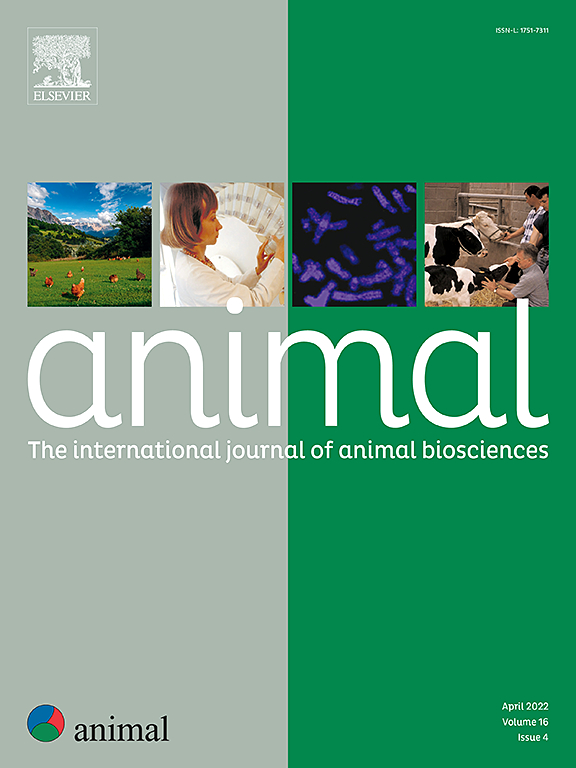Tail tip temperature measured by thermography as an indicator of animal health in Holstein cows
IF 4.2
2区 农林科学
Q1 AGRICULTURE, DAIRY & ANIMAL SCIENCE
引用次数: 0
Abstract
There is an increasing focus on animal health in research, and a growing public interest in transparent animal welfare practices. Several indicators are already used to assess animal health. Recently, the health of the tail tip has gained attention in animal welfare studies. Previous research suggests that circulatory problems may cause alterations in the tail tip. The aim of this case study was to evaluate whether tail tip temperature, measured using IR thermography, can be used as an indicator of animal health and whether visible or palpable alterations in the tail tip are associated with the tail temperature. We also compared the results with known animal health indicators using a cluster analysis. This study was conducted on a dairy farm in Germany. Data from 530 observations of 351 Holstein Friesian cows were collected over a 14-month period. The variables included the minimum, maximum, and average tail tip temperature; multiple tail tip alterations; the somatic cell score; the rectal temperature score; ruminal health indicators; the locomotion score; the body condition score; milk performance test results; and the sum of the claw diagnosis score. We used cluster analysis to identify patterns among these variables, resulting in the formation of four distinct clusters. The analysis revealed that the claw diagnosis score followed by tail tip temperature had the strongest influence on cluster categorisation, suggesting their notable influence on animal health. In the case study, cows with good performance and no obvious health problems showed unaltered and warm tail tips (non-standardised average temperature of 31.55 °C), whereas lower tail tip temperatures and altered tail tips tended to be associated with udder and claw issues, reduced rumen filling, and indications of potential health restrictions. Overall, a change in tail tip temperature was observed, supporting the previously hypothesised circulation issues. In addition, the correlations between the tail tip condition and several health traits in dairy cows suggest that the tail tip can be considered as an animal health indicator, and this issue warrants further investigation.
用热像仪测定荷斯坦奶牛的尾端温度作为动物健康指标
研究中越来越关注动物健康,公众对透明的动物福利实践也越来越感兴趣。一些指标已经用于评估动物健康。近年来,尾尖的健康问题已成为动物福利研究的热点。先前的研究表明,循环问题可能会导致尾巴尖端的改变。本案例研究的目的是评估使用红外热像仪测量的尾巴尖端温度是否可以作为动物健康的指标,以及尾巴尖端的可见或可触摸的变化是否与尾巴温度有关。我们还使用聚类分析将结果与已知的动物健康指标进行了比较。这项研究是在德国的一个奶牛场进行的。在14个月的时间里收集了对351头荷斯坦弗里西亚奶牛的530次观察数据。变量包括最低、最高和平均尾尖温度;多个尾端改变;体细胞评分;直肠温度评分;瘤胃健康指标;运动得分;身体状况评分;产奶性能测试结果;并对爪诊评分求和。我们使用聚类分析来识别这些变量之间的模式,从而形成四个不同的聚类。分析发现,爪诊评分对聚类分类的影响最大,其次是尾端温度,表明它们对动物健康的影响显著。在案例研究中,生产性能良好且没有明显健康问题的奶牛,其尾端温度不变且温暖(非标准化平均温度为31.55℃),而尾端温度较低和尾端变化往往与乳房和爪子问题、瘤胃充盈减少以及潜在的健康限制迹象有关。总的来说,观察到尾尖温度的变化,支持了先前假设的循环问题。此外,奶牛尾尖状况与几种健康性状的相关性表明,尾尖可以作为动物健康指标,这一问题值得进一步研究。
本文章由计算机程序翻译,如有差异,请以英文原文为准。
求助全文
约1分钟内获得全文
求助全文
来源期刊

Animal
农林科学-奶制品与动物科学
CiteScore
7.50
自引率
2.80%
发文量
246
审稿时长
3 months
期刊介绍:
Editorial board
animal attracts the best research in animal biology and animal systems from across the spectrum of the agricultural, biomedical, and environmental sciences. It is the central element in an exciting collaboration between the British Society of Animal Science (BSAS), Institut National de la Recherche Agronomique (INRA) and the European Federation of Animal Science (EAAP) and represents a merging of three scientific journals: Animal Science; Animal Research; Reproduction, Nutrition, Development. animal publishes original cutting-edge research, ''hot'' topics and horizon-scanning reviews on animal-related aspects of the life sciences at the molecular, cellular, organ, whole animal and production system levels. The main subject areas include: breeding and genetics; nutrition; physiology and functional biology of systems; behaviour, health and welfare; farming systems, environmental impact and climate change; product quality, human health and well-being. Animal models and papers dealing with the integration of research between these topics and their impact on the environment and people are particularly welcome.
 求助内容:
求助内容: 应助结果提醒方式:
应助结果提醒方式:


